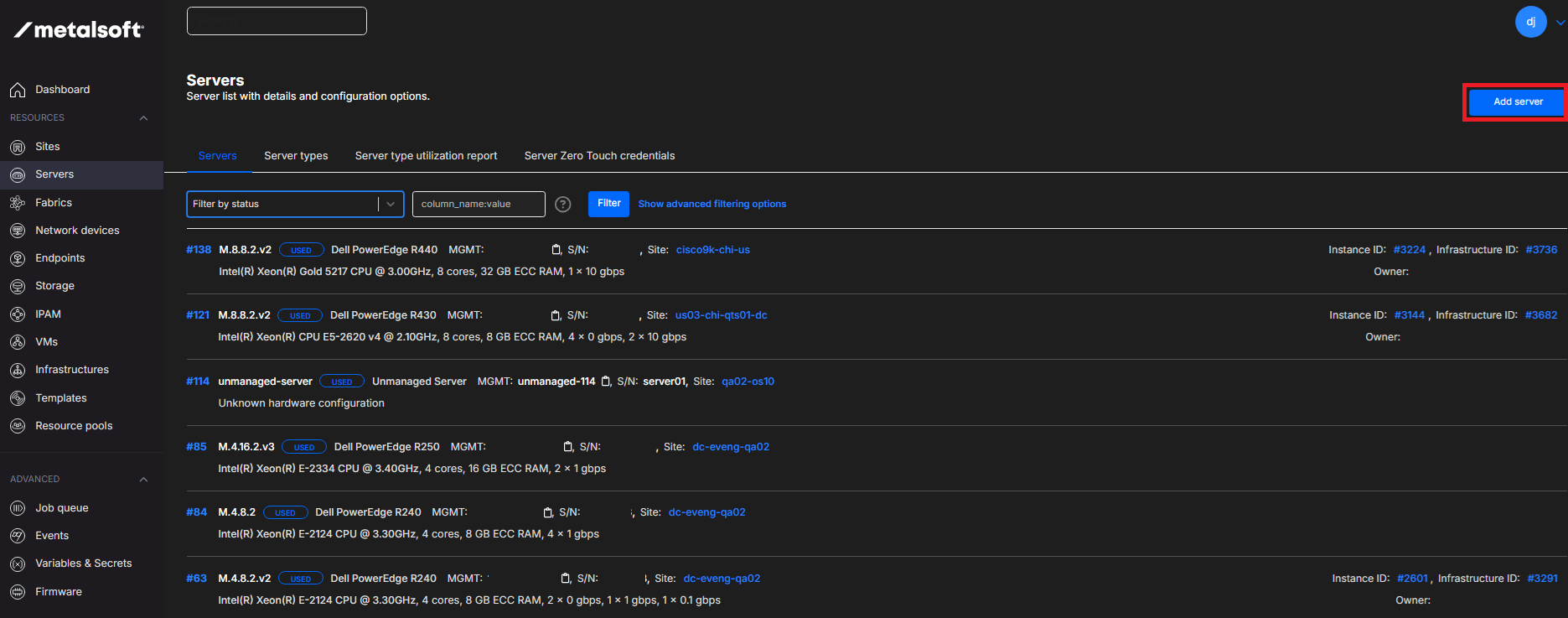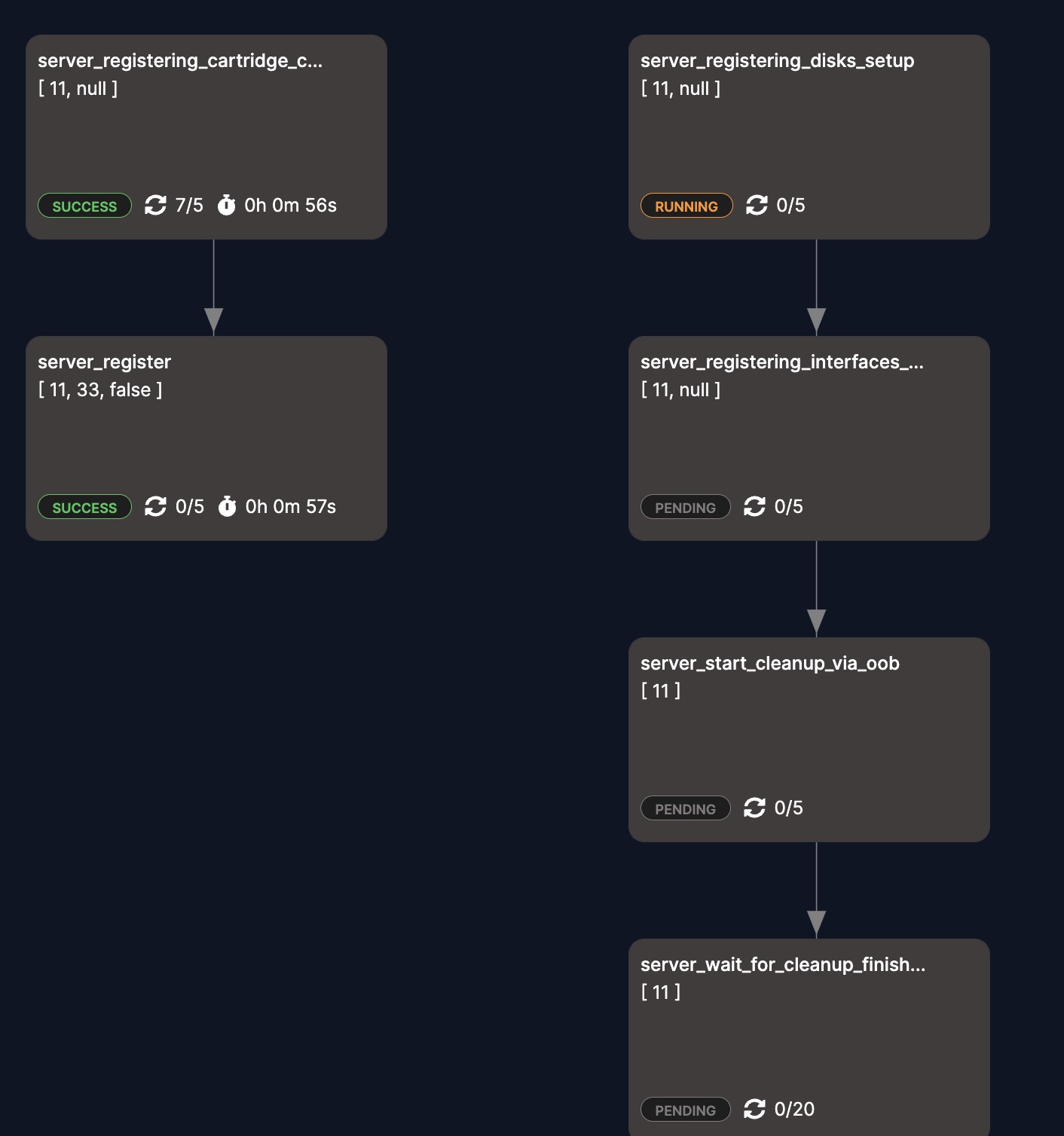Adding a new managed server
Adding a new managed server can be done in multiple ways:
- Via the UI, using the Add Server button from the Servers section of the Admin UI
- Via the CLI
- Via the “Zero Touch” registration process (only managed servers)
Adding a new managed server via the Add Server button
Section titled “Adding a new managed server via the Add Server button”This process is also known as “Server Registration”.
To register a new server navigate to Servers section, click the Add server button.

Select the vendor and input the BMC IP address and management credentials.

Click Add Server. The server will show up in the Registering state for up to 30 minutes.
During this process the system will connect to the BMC and extract all of the required information such as determine the firmware catalog, the switch connections etc.

At the end of the process the server will be in Unavailable state which means it is ready to be added to the pool by setting it to Available manually. This is a safety feature to prevent unauthorized devices from being added to the pool. If you wish to change this behavior, in the Admin UI, navigate to Sites, Site name, Configuration and select Automatically set servers as available and click Save configuration at the bottom of the page.
The server will be shutdown when in Available state to save energy. It will be powered on automatically when allocated to an infrastructure.
A server type such as M.2.4.5 will be automatically assigned based on the server’s characteristics. If a matching server type does not exist a new one will be created. If there is a matching server type but only a minor difference (such as the number of links) a new version of the server type will be created such as M.2.4.5v2. This server type can be changed later by the admin from the server’s Advanced tab.
During the registration process a link towards an AFC task graph can be seen in the Server’s overview page. It can be used to troubleshoot any registration issues.

Adding a new managed server via the CLI
Section titled “Adding a new managed server via the CLI”To start the registration process use the following command. Please ensure an OOB network is already set up. To find a list of vendors, run metalcloud-cli server register —vendor —help:
metalcloud-cli server register --model R1234 --serial-number ABCDE --site-id 2084 --vendor Dell --management-address 192.168.202.209 --username admin --password calvin
metalcloud-cli server register -config-source serverregconfig.jsonWhere serverregconfig.json contains the following sample information:
{ "siteId": 2084, "serialNumber": "ABCDE", "username": "admin", "managementAddress": "192.168.202.209", "vendor": "Dell", "password": "calvin", "model": "R1234"}Check the server status using the CLI:
metalcloud-cli server list┌─────┬──────┬───────┬──────────────────────────────────────┬───────────────────────┬───────────────┬────────────┬──────────────────────┬─────────────┐│ # │ SITE │ TYPE │ UUID │ S/N │ IP │ VENDOR │ MODEL │ STATUS │├─────┼──────┼───────┼──────────────────────────────────────┼───────────────────────┼───────────────┼────────────┼──────────────────────┼─────────────┤│ 139 │ 2080 │ │ 637F9200-D7B5-11EC-8000-3CECEFCEFCB0 │ S459124X3207796 │ 172.18.33.59 │ Supermicro │ SYS-510T-MR │ registering ││ 138 │ 2084 │ 10066 │ 44454c4c-3900-104a-8039-b4c04f483033 │ 49J9H03 │ 172.18.32.15 │ Dell │ PowerEdge R440 │ used ││ 136 │ 11 │ 10068 │ 70687704-945e-4566-85d2-130a11c2ad5e │ 00000 │ unmanaged-136 │ BSI │ Unmanaged Server │ available ││ 134 │ 11 │ 10068 │ f0b0620b-3e24-49f0-9a9d-ecbbab5931dd │ 00000 │ unmanaged-134 │ BSI │ Unmanaged Server │ available ││ 121 │ 2080 │ 10066 │ 44454c4c-5200-1036-804b-cac04f484c32 │ JR6KHL2 │ 172.18.33.61 │ Dell │ PowerEdge R430 │ used ││ 120 │ 1614 │ 10068 │ c633c660-b6d6-4b8c-a4b8-46a1781ee7aa │ test │ unmanaged-120 │ BSI │ Unmanaged Server │ available ││ 117 │ 1614 │ 10068 │ cdc774a3-57d5-49eb-a746-e626d0af6bb9 │ server04 │ unmanaged-117 │ BSI │ Unmanaged Server │ available ││ 116 │ 1614 │ 10068 │ 60ecbe41-f05e-4a44-b981-3a7c01fbf308 │ server03 │ unmanaged-116 │ BSI │ Unmanaged Server │ available ││ 114 │ 1614 │ 10068 │ a782a6a6-fae5-4ac0-ab8d-3916708d034b │ server01 │ unmanaged-114 │ BSI │ Unmanaged Server │ used ││ 86 │ 2080 │ 10067 │ 44454c4c-3800-1030-805a-b8c04f533532 │ 880ZS52 │ 172.18.33.62 │ Dell │ PowerEdge R430 │ available ││ 85 │ 11 │ 10079 │ 44454c4c-4c00-1043-8056-c7c04f4d5333 │ GLCVMS3 │ 10.255.148.39 │ Dell │ PowerEdge R250 │ used ││ 84 │ 11 │ 1537 │ 44454c4c-4800-1053-8046-b9c04f514633 │ 9HSFQF3 │ 10.255.148.41 │ Dell │ PowerEdge R240 │ used ││ 68 │ 1614 │ 10062 │ 38363739-3538-4D58-5138-323230325056 │ MXQ82202PV │ 10.255.148.46 │ HPE │ ProLiant DL360 Gen10 │ available ││ 67 │ 2080 │ │ │ S367023X9925464 │ 172.18.33.60 │ Supermicro │ AS -1114S-WTRT │ registering ││ 63 │ 11 │ 7736 │ 44454c4c-5a00-1047-8046-b7c04f314433 │ 7ZGF1D3 │ 10.255.148.40 │ Dell │ PowerEdge R240 │ used ││ 53 │ 558 │ 29 │ 68a73015-2aa3-4761-abed-d98bf1b8ce1c │ dummy_serial_server01 │ unmanaged-53 │ BSI │ Unmanaged Server │ available ││ 52 │ 558 │ 29 │ f00dc4c5-8c6d-4cbe-87dd-92f9ee0893ce │ dummy_serial_server04 │ unmanaged-52 │ BSI │ Unmanaged Server │ available ││ 51 │ 558 │ 29 │ 0ccc1af5-156e-40ae-8e08-c6394e25055a │ dummy_serial_server03 │ unmanaged-51 │ BSI │ Unmanaged Server │ available ││ 49 │ 558 │ 29 │ 154fb4ee-52d2-4369-a4ff-0f61a68b8c5e │ dummy_serial_server02 │ unmanaged-49 │ BSI │ Unmanaged Server │ used │└─────┴──────┴───────┴──────────────────────────────────────┴───────────────────────┴───────────────┴────────────┴──────────────────────┴─────────────┘Adding a new server via Zero Touch
Section titled “Adding a new server via Zero Touch”Consult Registering servers using ZTP for more details on this process.
Default RAID configuration
Section titled “Default RAID configuration”The system will automatically create a RAID array on supported systems when servers are registered based on the default cleanup profile.
Consult the HCL for details on which servers are supported and under which conditions. Some additional licenses might be required in order for this feature to be available.
The default RAID configuration profile describes the following scenarios which depend on the size and number of drives.
For each group of identically sized drives (added to the same RAID controller) for the following count of identical drives:
- 1 device -> RAID 0
- 2 devices -> RAID 1
- even number of devices -> RAID 10
- odd number of devices -> RAID 5
Note that, if enabled end-users can also specify a Custom RAID configuration that will override this raid configuration. To allow a user to configure a RAID profile, the “Allow custom RAID configuration” user limit must be enabled from Users & Permissions > User > Limits.
Dell BOSS controllers only support a single drive in RAID 0, or 2 drives in RAID 1. Some BOSS controllers support the drives in non-RAID configuration. Please check the Dell website for more information.
Server-only operation
Section titled “Server-only operation”MetalSoft can register and deploy servers without having access to the TOR switches. However some extra manual steps are required if IP allocation and network configurations are required inside the operating system:
- Create a new Ethernet fabric. This fabric will not have any switch devices added to it but will still have logical networks, IPs etc.
- On the Fabric’s Configuration page select “Enable server-only operation”
- On all the servers, after registration,from the server’s network interfaces tab, for each network interface that is connected to an interface on the switch side th click “Manual fabric and redundancy group mapping”. If the switches have link aggregations setup select “Full” then select the Fabric created above from the dropdown. If the server’s port that is being managed is connected to a member of a link aggregation on the switch-side, input also a “redundancy group index” that is unique (0-99) for that link aggregation.
- Now, inside the Infrastructure Designer use logical networks created in the Fabric created at point 1. to specify what VLANs, IPs etc should be provisioned on the operating system. Specify a redundancy group index on the conenction if a specific link aggregation group is to be used to transport the respective logical networks’ VLAN.
Troubleshooting
Section titled “Troubleshooting”Check the Server Registration Troubleshooting for more details.